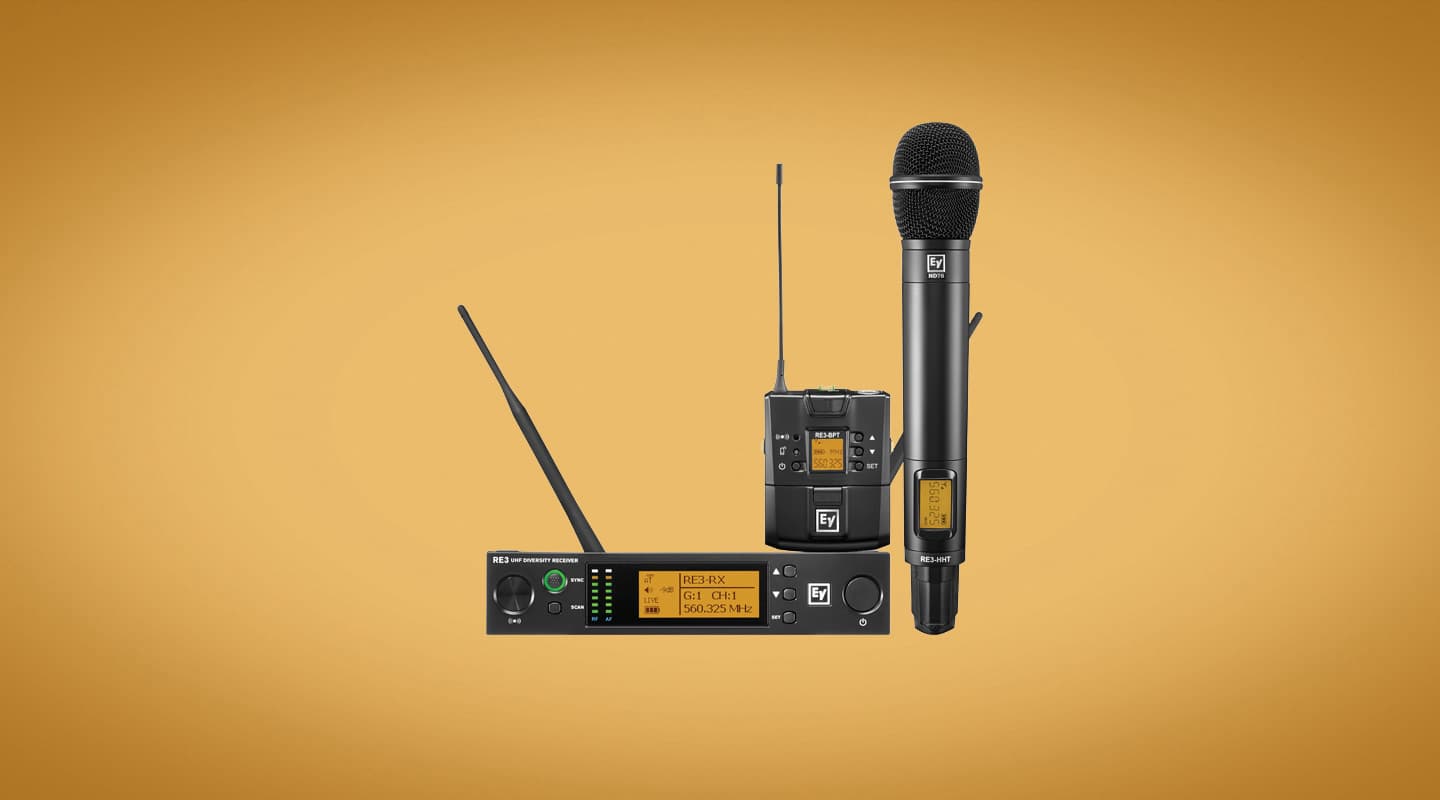
Review: Electro-Voice RE3
This new wireless microphone system from Electro-Voice offers a variety of handheld and bodypack solutions to suit a wide range of applications, along with unique designs, attention to detail and solid sound.
Review:/ Mark Woods
Electro-Voice has a long and illustrious history, but may not be the first name that comes to mind when thinking about wireless systems – most likely it will be one of the other big brands that dominate the professional end of the business. EV is one of several companies challenging that domination by offering products of comparable performance, but with their own unique designs and sonic characteristics.
Its recently released RE3 system replaces their ageing RE2 range with all-new designs, improved performance and more contemporary looks. Operating analogue in the UHF frequency range between 560MHz to 596MHz, it’s capable of operating eight groups of 22 channels concurrently. The UHF frequency range has some international geographic restrictions and exists at the whim of government regulation, but offers increased multi-channel capability and zero latency compared to competing 2.4GHz systems.
Designed for professional stages and beyond, the RE3 system can be purchased as pre-packaged sets or as separate components. Each set starts with a standard half-rack space RE3 receiver with either a handheld transmitter and a choice of five interchangeable capsules, or a bodypack with an even larger choice of hands-free input devices. The mounting on the handheld transmitter is a standard 1.25 inch thread so capsules from other manufacturers will fit if you wanted to try them. For larger productions with multiple channels the optional accessories include antenna splitters, active or passive LP antennas and a two-slot battery charger/dock.
RECEIVER: ORANGE THE NEW BLACK
The RE3 receiver is a black metal box with longer than usual black antennas attached to the rear panel, along with a balanced XLR and an unbalanced 6.35mm socket. The universal power supply probably reduces manufacturing costs slightly, but the Australian adaptor is significantly wider than the power supply itself so you can’t put anything directly next to it on a regular 240V power board.
The front panel looks like a small part of a digital console when it’s on; the orange-backed LCD, candy-coloured strips of lights for RF and AF levels, and a green circle of light around the Sync button make for a somewhat uncoordinated but colourful display. The screen is not as sharp as the new OLED screens but the contrast is adjustable and everything is big and clear enough. The receiver is simple to navigate with just a small learning curve to get fluent with the buttons and their options. If you’re only using a single mic you’d rarely need to change anything once set up.
HANDHELD HEADS
The RE3 HHT handheld transmitter is aluminium with a smooth satin-black finish. The orange-backed LCD screen is towards the bottom of the mic inside a slightly raised frame. The plastic housing on the tail section has a neat sliding lid that exposes nudge buttons to manually change the operating frequency. The Power/Mute button is half hidden under the edge of the housing and takes a deliberate action to engage. Pressing it briefly mutes the mic, holding it just a little longer turns the power off.
The fun starts with the selection of capsules and these are an interesting bunch. The ND76, ND86 and ND96 wired dynamic mics have only been around for a couple of years but their roots go back in time. The ND Series replaced the popular N/D Series that replaced the original N/DYM Series from the mid ‘80s. As well as pioneering the humbucking coil, EV were the first company to use neodymium magnets in their microphones; hence the names. They also use a large Mylar diaphragm that is light and fast. The size gives fullness to the lows and mids, the light weight delivers accurate transients and the result is a modern, clear sound with a high output.
MORE INFO
PRICE
Systems from $1210
CONTACT
1300 026 724
[email protected]
boschcommunications.com.au
PROS
Sound character
Build quality
Variety of input options
CONS
Dated screens
SUMMARY
A well designed and good-sounding competitor to the dominating brands, with a wide range of options for assembling handheld and bodypack solutions to suit most applications.
ND & RE HANDHELD OPTIONS
The ND76 is a general-purpose, fairly wide cardioid dynamic mic and the cheapest. The ND86 steps up in price and performance with a tighter pattern and more focussed sound. The ND96 is crazy – the head is nearly flat like it’s been sliced off but it gets you right on the diaphragm for maximum level. Made to be eaten, the sound is bright and aggressive; it copes with the most intense screaming without overloading, and it can be absolutely cranked in the monitors without feeding back. It’s a heavy metal special.
The other capsules are from the new RE420/RE520 condenser microphones. These upgrade the RE410/510 mics with better looks and performance. Designed for live shows, the wired versions are still kinda plain looking but practical and tough; they look more serious mounted on the handheld wireless transmitter. For live vocals condenser mics are accurate and detailed compared to dynamics, with a larger sweet-spot and greater working distance, but they can be unruly in the monitors if you’re looking for more than medium volume. The RE420 condenser is the cardioid version with maximum feedback rejection directly behind the mic. A perfect mic for strident female voices, the sound is warm and appealing with the well-controlled high-mids helping to avoid both harshness and feedback. This combined with a fairly tight pattern makes for excellent foldback levels, especially for a condenser. The slightly scooped frequency plot sees a wide boost centred around 100Hz and a bit of added sparkle around 6kHz, but then not so much from 8kHz to 10kHz, where some condensers are spiky and try to take off. Proximity effect is well controlled but for those who like to get right on the mic the gentle 150Hz HPF located under the grille keeps the low end tidy.
The RE520 is the hyper-cardioid version with maximum rejection at 125 and 225 degrees off-axis. I like using a pair of wedges at about those angles rather than a single wedge right in front of the performer, partly to get the extra level from two speakers but also because I don’t like to block the view of the performer’s feet – they might have gone to a lot of trouble to choose their shoes. The RE520 is a tighter pattern and more focussed than the RE420 but they’re similar overall and they share low-handling noise and effective pop shields.
MAMMOTHS ARE UNSTOPPABLE
Castlemaine’s funky all-girl band Stop That Mammoth were performing at the Theatre Royal while I had the mics. Young and enthusiastic and fairly noisy on stage, they’re the sort of band you’d usually give time-proven dynamic mics – partly for familiarity, and partly to ensure easy level on stage and in the house if they don’t sing very loudly. But those regular dynamics, with their exaggerated proximity effect and added presence in the high-mids, can sound harsh on bright voices and they do turn thin when the singer gets off the mic. The RE520 had neither of these concerns; singer Shanti had a ball and everyone was pleasantly surprised at the fidelity and stability. Add in the reasonable selling price and these are a good thing.
“”
If you’re only using a single mic you’d rarely need to change anything once set up

BODYPACK
The wide range of transmitter devices that are not handheld contains eight varieties of headworn mics, five flavours of lavalier mics, two lapel mics, a clip-on instrument mic and a couple of leads with 6.35mm jacks. Some of those are for music but most cover theatrical, corporate or action sports applications. They all connect to the EV RE3-BPT bodypack transmitter.
The smaller and lighter the better with bodypacks, but they still have to be strong in the ‘prima donna tantrum’ sense, and hold a couple of AA batteries. The batteries in the RE3-BPT bodypack take up nearly half the size of the unit and close to a third of its weight so it’s obviously an efficient design, and it looks techy in its magnesium shell.
The rear panel is taken up with a large strong clip, while the front panel has a small screen. Under the screen a latch opens the front cover. Books have been written about whether to put the power switch dangerously but conveniently exposed or safely but inconveniently hidden under a cover. I know where EV stands; the only things under the cover here are the batteries. Sunken nudge buttons flank the screen, three for selecting frequencies on one side, on the other side the sunken power button, a low battery indicator and the sync port. It works for me. The power button is fiddly to engage and needs to be held for a good couple of seconds before the bodypack turns off, but thoughtfully turns on instantly if you accidentally turn it off, realise what you’ve done, and need it back on again ASAP. The potentially frequency-changing Set button also needs a deliberate action to engage, so no accidents there hopefully.
The top of the RE3-BPT bodypack is the only place the performer needs to be. Right in the middle of the top is a chunky, raised and lit Mute switch. It’s super easy to feel with a positive click when activated, and lights up green for go or flashes in red for mute. You could use it confidently with thick gloves. Outside the switch a cute antenna is permanently fixed to the bodypack and a secure mini four-pin socket connects the chosen input device. The screen is more for convenience, displaying the current frequency and battery level. As with the receiver, it starts flashing when the battery is getting low.
LAV’ING A BALL
I tried just a sample of these hands-free input devices. It’s more about the mounting than the mic with these things. The RE3-CL3 (cardioid) and RE3-OL3 (omnidirectional) lavalier mics are tiny and intricately made. It seems a shame to hide their looks under the equally tiny foam pop shield but they definitely need the protection from plosives. The super-cardioid condenser HW3 headworn mic’s specialty is presentations or performances involving lots of movement. It’s a well-executed design for what is a potentially awkward object; the frame is comfortable, easy to adjust and works if you’re wearing glasses. The mic is on the end of a gooseneck/shockmount that allows for fine adjustment but holds firm if you jump around. If you take the unit off and put it down it will be in the same place when you put it back on. Attention to detail and an experienced focus on the task applies to all the devices across the RE range.
SOLID PERFORMANCE
In use, the RE3 system seems solid with no glitches or drop-outs, but that’s the same with other brands I’ve used or reviewed; mine may be simple applications but they all seem stable. With handheld wireless mics the biggest difference between brands is the capsules/preamps and this is where the RE3 competes on even ground; both the ND range and the new RE420/520 mics/capsules have their own strengths and character and if they suit the user then that’s the right mic for them. The hands-free range of input devices is comprehensive and combines quality mics with clever design. The RE3 wireless system is a worthy competitor.

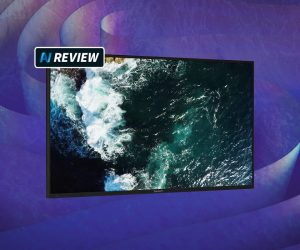
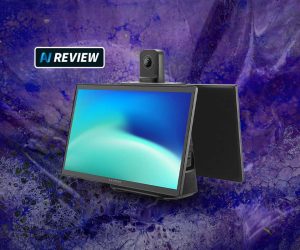




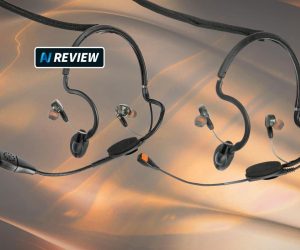
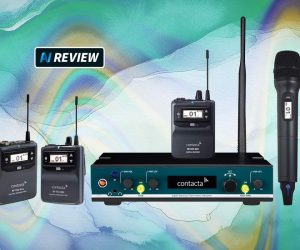


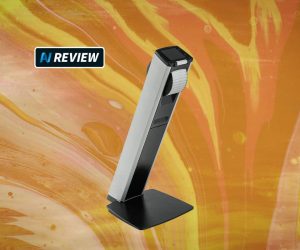



RESPONSES